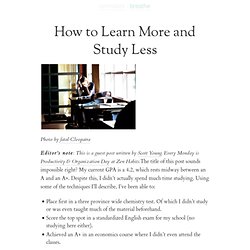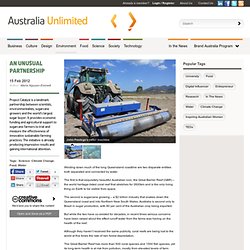

How to Learn More and Study Less. Photo by fatal Cleopatra Editor’s note: This is a guest post written by Scott Young.

Every Monday is Productivity & Organization Day at Zen Habits.The title of this post sounds impossible right? My current GPA is a 4.2, which rests midway between an A and an A+. Despite this, I didn’t actually spend much time studying. Using some of the techniques I’ll describe, I’ve been able to: Place first in a three province wide chemistry test. I say all this not to boast about how great I am, because I feel my accomplishments are rather modest compared to many people I know. More studying time won’t help if the way you are studying is flawed to begin with.
Holistic Learning Smart people don’t just learn better. Holistic learning is basically the opposite of rote memorization. Excessive studying shows you aren’t learning holistically. How to Boost Your Study Habits Holistic learning isn’t like a brainstorming technique or mind-mapping. Visceralize – You’ve probably heard of visualizing, right? How to Learn Without Memorizing.
Photo by Edwin Stemp Rote memorization is an inefficient way to learn.

Just retaining a single formula can mean pounding the same information into your skull dozens of times. If your computer hard drive had this accuracy, you’d probably throw it out. Unfortunately, you’re stuck with your brain. The good news is that you don’t need to learn by memorization. A few years ago, I noticed that smart people seemed to learn differently than most other people. While there are undoubtedly some genetic advantages that allow some people to learn effortlessly, I think part of this difference in success comes down to strategy. Is Your Brain a File Drawer or a Web of Ideas? A computer stores information as thousands of electrical 1s and 0s in a linear fashion. However, your brain isn’t a sequence of bits and bytes, so this approach doesn’t make sense.
Other Forms of Learning There are lots of ways you can learn creatively: 1. Connect ideas together by relating them to something you already understand. Australian Sugarcane - About the Australian sugarcane industry. An unusual partnership. Winding down much of the long Queensland coastline are two disparate entities both separated and connected by water.

The first is that exquisitely beautiful Australian icon, the Great Barrier Reef (GBR) – the world heritage-listed coral reef that stretches for 2600km and is the only living thing on Earth to be visible from space. The second is sugarcane growing – a $2 billion industry that snakes down the Queensland coast and into Northern New South Wales. Australia is second only to Brazil in sugar production, with 80 per cent of the Australian crop being exported.
But while the two have co-existed for decades, in recent times serious concerns have been raised about the effect runoff water from the farms was having on the health of the reef. Although they haven’t received the same publicity, coral reefs are being lost to the world at five times the rate of rain forest depredation. But it’s not just an Australian concern; polluted runoff from farming practices is a worldwide problem.